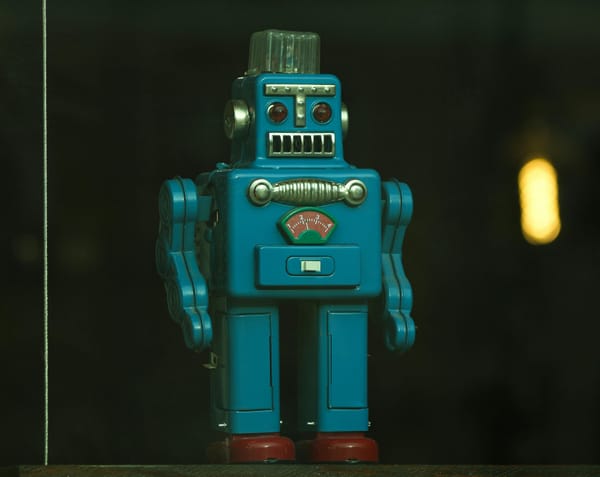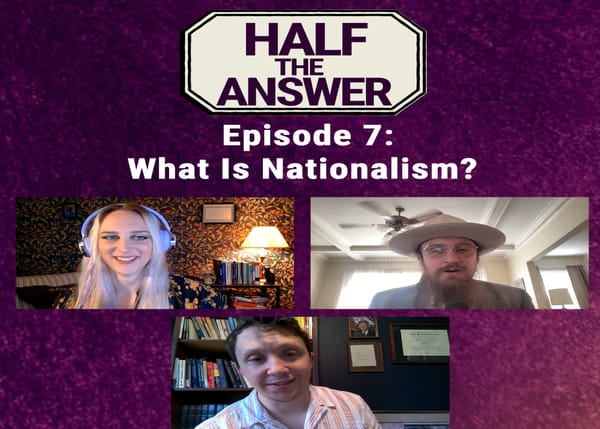The Illiberal's Dilemma

In January of this year, media personality Matt Walsh tweeted “Singapore is able to have nice things in part because they execute drug dealers by hanging and arrest even petty vandals and thieves and beat them with a cane until they bleed. We don’t have nice things because we aren’t willing to do what is required to maintain them.” What is striking about this claim is the degree to which even illiberal activists like Walsh, who have made it their mission to oppose the modern world and return us to pre-modern structures of hierarchy and domination, are irretrievably infected by the logic of modernity. On an emotional level, what he thinks is “Drug dealers are sinners and should be scourged,” but he even to himself wraps this up in a materialist logic: “Drug dealers should be scourged because that will bring us prosperity.”
Everybody wants what modernity offers. And all the illiberals are tying themselves in knots trying to fit their own philosophy to it—hence the bizarre association of technological progress with caning people for smoking weed. Meanwhile, in the America that actually exists, weed is big business: the increasing legalization of marijuana has transformed it into a hundred-billion-dollar a year industry.
I want to explore this tension. My claim is that all contemporary illiberal movements face a fundamental problem: the illiberal’s dilemma. On the one hand, everybody wants what modern prosperity offers—power, comfort, security, wealth. On the other hand, illiberals reject what makes modern prosperity possible—freedom, diversity, the continual churn of change. We can taxonomize different varieties of illiberalism according to how they attempt to square this circle—from the herrenvolk democracies to the petro-dictators to the authoritarian capitalists. And perhaps we liberals can take our own lessons from their failures.
The Magic Beast
But before turning to the illiberal’s dilemma, a bit of essential stage-setting: a brief history of economic growth, 50,000 BCE to present. The facts I am about to rehearse here are commonplaces among economic historians, they are not well-known among the general public.
Prior to 1800, long run per capita economic growth was flat. In other words: for the first fifty thousand years after the invention of agriculture, the overall productivity of people didn’t change very much. Specific societies and places might see small periods of gradual enrichment—but these were, invariably, followed by contraction. And there were always more mouths to feed. Most people, for most of history, lived around the level of subsistence—above it, if they were lucky; below it, if they were not.
Around the year 1800, give or take a few decades, this changed; it changed in a specific place—England—and spread outwards from there. Long-run per capita economic growth started to average between 1 and 3 percent a year. Three percent growth might not sound like much, but compounded over a generation it means an economy that doubles in size every 25 years or so. Even over the lifetime of a single individual, this represents an astounding rate of progress. Children could expect to be twice as rich as their parents, and their children twice as rich as that. The impact of this on world history is hard to overstate: for the first time, there was enough to go around to guarantee every citizen not merely a decent life, but a luxurious one. The average individual in the modern world works less, earns more, and lives a life of security and comfort that would have been unimaginable to even the richest kings in the world in 1700.
This change was driven by a shift in the nature of technological progress. Modern wealth does not consist of the same stuff that existed in 1700, “only more of it.” We are not sitting on a giant pile of shovels, potatoes, wooden shoes and roughspun wool. Instead we made better stuff and we made it in new ways and we made it in incomprehensible quantities. This does not mean that growth depended on rare world-shaking inventions. Rather, it depended on tinkerers’ tweaks, ideas a mere two or three percent better than the previous one—but three percent, compounded over decades, turns out to be quite a lot. Modern economic growth is quite simply about the steady progress of technology and innovation
This sustained technological innovation is a product of a deeper change in culture, politics, and social form. In particular, it is a product of the transition from closed to open societies: societies in which increasingly large sections of the population have access to economic, political, and social participation. In particular, liberal democracy seems to be the social form best suited to generating, disseminating, and sustaining continual innovation. This is a less widely accepted theory among economic historians, but one for which there is strong evidence.
Here’s how that works in practice. An individual sees an opportunity to make things a little better or do things a little better. Maybe that means economically, and it gets them more money. Maybe that’s politically, and it gets them more votes. Maybe that’s socially, and it gets them more esteem. And at the same time, everyone else is constantly doing the same thing. And some of these experiments work and some of them don’t, and what works one year might not work the next. But on the whole, the continual ferment of experimentation produces some good ideas—not great, necessarily, but on the whole two or three percent better than what came before.
And of course there are winners and losers. Sometimes the churn produces mRNA vaccines, cheap solar power, rechargeable batteries that last for days and days, a universal translator in your pocket. Other days it produces leaded gasoline, acid rain, and black lung disease. That’s why liberal democracies also include mechanisms for addressing the common good in a democratic fashion: environmental protection, workers’ rights, welfare and social security. They distribute the stresses and strains of a society in continual motion without fracture. And so everyone is mostly okay with letting everyone else pursue their own perception of the good (or at least the slightly better) while they themselves pursue theirs.
This might all sound like a fairy tale except for the part where it works pretty well in practice. All that is solid melts into air, as the man said. What he didn’t add is that at the very same time new and better things are coalescing out of the air all around you.
The Illiberal’s Dilemma
The picture of modern prosperity outlined above poses a problem for illiberals. The fundamental nature of illiberalism—regardless of which palette-swap reactionary movement we’re talking about—is a pervading and indeed pre-intellectual libidinal love for hierarchy—for status, power, order, and violence. As the famous Wilhoit Proposition puts it: “Conservatism consists of exactly one proposition, to wit: there must be in-groups whom the law protects but does not bind, alongside out-groups whom the law binds but does not protect.” This of course gets dressed up in various ways, ethnic or religious and always, always patriarchal guises, but the fundamental idea is the same: there are some people who belong on top, and good things should accrue to them, and other people who belong on the bottom, and bad things should accrue to them, most especially domination and inferiority. Of course, being on top of the hierarchy in the modern world requires having all the stuff that modernity produces: the weapons, the medicines, the media, the food, the travel, the abundance, the everything. Everyone wants the stuff. No conservative who longs for an earlier age suggests cutting themselves off from the modern world in an intentional community, as the Amish have—because that would mean accepting an inferior place in the hierarchy of power.
The illiberal’s dilemma is therefore simple: modern economic growth and especially the continual churn of new productive technologies is inimical to the maintenance of stable status hierarchies. Consider one historically central example. The pre-modern world saw wealth and power based very consistently on a single thing: ownership of land, and the rents accruing therefrom. The industrial revolution increased the productivity of land—and, paradoxically, decreased the power of landowners, as they became an increasingly small fraction of the overall economy. Land became worth less and less as compared to industrial development—and, suddenly, our political and social worlds stopped orbiting around the big farmer up on the hill. A stable status hierarchy is a closed loop of political, economic, and social domination. The continual emergence of new and more efficient modes of production inherently threatens such loops.
This dynamic recurs over and over. Coal baron from West Virginia? Sad news, new solar plants are cheaper than existing coal plants, and all those billions in assets you had buried beneath the ground are rapidly ticking down to zero. Don’t like Jim Crow? Move north and get a factory job. Your father wants you to be a boy? Move to the city and work as a coder.
Modern illiberalism is driven by an attempt to square this circle: to maintain old hierarchies while participating in modern abundance. This allows us to analyze our varied cast of authoritarians in simple terms.
Varieties of Illiberalism
I want to focus on three contemporary illiberal formations: petro-dicators, herrenvolk democracies, and authoritarian capitalists. Each of these seeks to separate the churn of modernity and the stability of hierarchy in a different way. And each of them struggles to maintain that balance—in a different way.
Petro-dictators respond to the illiberal’s dilemma by displacing modernity in space. “Modernity abroad, repression at home,” with the gap bridged by the extraordinary wealth that oil brings. The fruits of modernity are purchased and imported, sustaining the wealth and power of the elite in their home countries. The Kingdom of Saudi Arabia is the model here. The Kingdom is blessed with immense resource wealth in the form of gigantic deposits of light, sweet crude oil; this oil is one of the fundamental resources of the modern world; for decades it has been in extraordinarily high demand by the industrial economies of the world. This has allowed the House of Saud to sell oil, buy modernity, and keep their pleasing hierarchies intact.
This dynamic is sustained by the fact that oil requires an unusually small industrial footprint relative to its productivity. Pumpjacks and pipelines don’t run themselves, but the labor required is a fraction that of a coal mine and a railroad. Refining can take place abroad; advanced drilling machines can simply be purchased on the world market with oil revenues. The educated, skilled workforce that might otherwise demand social reforms can be kept at arm’s length from the petro-dictator.
Is this sustainable? Well, it worked pretty well for a long time. But the churn never stops. And these days the petro-dictators themselves are signaling pretty hard that they can read the writing on the wall: the green transition is coming, and “peak oil” no longer refers to the moment we run out, but the moment its price starts dropping and never stops, because new technology has enabled us to produce better products without oil. Hence Mohammed bin Salman’s increasingly outlandish pitches for ultramodern hubs of tech and finance built from whole cloth in the Saudi desert. Of course, if the foregoing arguments are correct, none of these are going to work without reform of the Kingdom’s political and social systems, because who wants to bank with a man who will have you cut apart with bone saws if you don’t like the interest rate.
Herrenvolk democracies respond to the illiberal’s dilemma by displacing modernity socially instead of physically. “Modernity for me, hierarchy for thee.” The model here is Orbán’s Hungary. Such states propose to offer the benefits of modern liberal democracies (democracy, rights, economic growth) to certain citizens, while simultaneously stripping it from others members of that very society—women, ethnic minorities, queers, and immigrants are generally at the top of the list here. This nominally provides the benefits of both modernity and hierarchy to those fortunate enough to be members of the true Volk.
As it happens, this does not work particularly well in practice. While Hungary might be beloved of America’s own eurofascist Claremont Institute, the Claremont bros typically neglect to mention that Hungary has the GDP of a mid-sized American city, and only achieves that much because it receives approximately ten percent of its own GDP in EU subsidies.
Indeed, herrenvolkism has a quite predictable tendency to produce economic stagnation. They trend towards cronyism—towards a political economy not of growth and innovation, but favors and kickbacks. Letting the authoritarians into politics lets them pick winners and the losers—and mostly they like to pick their friends, it turns out. This feedback loop between government cronyism and support for herrenvolkism is central to its political economy—call it “rule by car dealership owner.” To the extent that herrenvolkism appears economically sustainable, it’s usually because it’s leeching off modernity in some obscure fashion.
Authoritarian capitalists respond to the illiberal’s dilemma by trying to establish a separation between the political and the economic spheres. “Modernity for the economy, hierarchy for politics.” The model here is, famously, China. From 1958 to 1976, Mao Zedong led China from the catastrophe of the Great Leap Forward to the catastrophe of the Cultural Revolution, killing tens of millions of Chinese citizens to no appreciable benefit, economic or otherwise. But beginning in 1978, Deng Xiaoping began a series of economic reforms intended to introduce a measured degree of capitalism into Chinese society while maintaining a stable but closed political system of rule by the Communist Party. The results, as we all know, were extraordinary, transforming China from starving backwater to industrial powerhouse.
Is this system sustainable? Maybe. But recent events suggest that things are breaking down in predictable ways. Xi Jinping has begun killing off profitable industries (like tech) and lifting up unprofitable ones (like farming). Combined banking and real estate crises signal an economy that is struggling to rebalance itself in the face of economic and demographic transitions. Decades of export-led industrialization produced a specific kind of power base. But now the churn continues, and its closed political system is struggling to manage the resulting shifts in power and prestige without fracturing. And Xi’s increasingly incompetent meddling in the economy shows no signs of slowing. Given the power wielded by personalist dictators, it is less than clear that a neat separation between an open economy and a closed political system is sustainable in the long run.
The Liberal’s Dilemma
So much for the illiberals and their dilemmas. There is a lesson here for we liberals as well. We too are confronted with the relentless churn of modern capitalism, this magic beast that throws up prosperity. And the chaos of it all offends our sensibilities. Surely there is so much waste. Fast food, fast fashion, all that cheap plastic crap filling up our landfills—surely we could direct it all in a better way.
This aspiration is given its latest expression in the contemporary “degrowth” movement, which aspires to reorient the world economy around not “profit” but “real human need.” It is therefore worth considering other historical attempts to harness the magic beast of modernity to total state control. And here we come to one project I have conspicuously failed to mention, because it was neither illiberal in conception nor liberal in execution: the Soviet Union. The great attempt at world communism began with the best of intentions: to overthrow oppression and liberate the people of the world.
Its planned economy promised to out-grow and out-produce wasteful capitalism by focusing not on profit but social need and genuine productivity. It was run according to top-down directives about how much of what kinds of material goods to produce. While the Soviets did not aim at degrowth but world preeminence, their failures are instructive. Unable to deliver steady per capita productivity growth, they compensated with natural resource extraction and Western debt. This practice of selling oil and importing advanced machinery has a certain parallel with the methods of petro-dictators: modernity abroad, hierarchy at home.
But the facade could only be sustained so long, and in 1991 the Soviet Union would collapse entirely after Gorbachev’s failed attempts at economic and political liberalization. Like other non-liberal regimes before it, the Soviet Union failed to deliver the continual technological innovation and economic dynamism that sustains modern growth. That growth requires the freedom to experiment according to your own perception of the good—a freedom that is incompatible with the goals of degrowth, as my colleague Paul Crider has argued.
From this world-historical debacle, certain liberals have drawn the lesson that the free market must be free, and the great task is to keep “politics” out of markets to the greatest extent possible. In a grimly ironic turn of events, the Soviet Union would once again be the ideological experiment-ground for ideological imports from the West. In 1991, the “best and the brightest” would bring unbridled free market capitalism to Russia—with results that are now painfully evident. Robber barons carved up the government into their own little fiefdoms, the economy (outside of oil windfalls) continued to stagnate, and now the country is being led to ruin by crooks and warlords. Capitalism without liberalism is just feudalism with a different name.
We liberals can therefore take our own caution from this history. The magic beast of modernity produces immense economic growth—so long as it is neither left completely free to run wild, nor broken completely to politicians’ saddles. That is the liberal’s dilemma.
Featured Image is Viktor Orban, by Herve Cortinat





